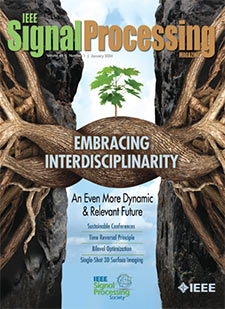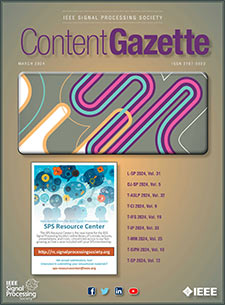- Our Story
- Publications & Resources
- Publications & Resources
- Publications
- IEEE Signal Processing Magazine
- IEEE Journal of Selected Topics in Signal Processing
- IEEE Signal Processing Letters
- IEEE/ACM Transactions on Audio Speech and Language Processing
- IEEE Transactions on Computational Imaging
- IEEE Transactions on Image Processing
- IEEE Transactions on Information Forensics and Security
- IEEE Transactions on Multimedia
- IEEE Transactions on Signal and Information Processing over Networks
- IEEE Transactions on Signal Processing
- IEEE TCI
- IEEE TSIPN
- Data & Challenges
- Submit Manuscript
- Guidelines
- Information for Authors
- Special Issue Deadlines
- Overview Articles
- Top Accessed Articles
- SPS Newsletter
- SigPort
- SPS Resource Center
- Publications Feedback
- Publications FAQ
- Blog
- News
- Dataset Papers
- Conferences & Events
- Community & Involvement
- Professional Development
- For Volunteers
- Information for Authors-OJSP
-
Home
An Exciting Juncture for Signal Processing Research: On Building Bridges, Challenges, and Opportunities
Conferences Events IEEE JSTSP Article IEEE Signal Processing Magazine IEEE TIFS Article IEEE TMM Article IEEE TSP Article Jobs in Signal Processing Lectures Machine Learning Seasonal Schools Signal Processing News SPM Article SPS Distinguished Lectures SPS Newsletter Article SPS Webinar SPS Webinars SPS Webinar Series Webinar webinars -
Our Story
What is Signal Processing?

The technology we use, and even rely on, in our everyday lives –computers, radios, video, cell phones – is enabled by signal processing. Learn More » -
Publications & Resources
-
SPS Resources
- Signal Processing Magazine The premier publication of the society.
- SPS Newsletter Monthly updates in Signal Processing
- SPS Resource Center Online library of tutorials, lectures, and presentations.
- SigPort Online repository for reports, papers, and more.
- SPS Feed The latest news, events, and more from the world of Signal Processing.
-
SPS Resources
-
Conferences & Events
-
Community & Involvement
-
Membership
- Join SPS The IEEE Signal Processing Magazine, Conference, Discounts, Awards, Collaborations, and more!
- Chapter Locator Find your local chapter and connect with fellow industry professionals, academics and students
- Women in Signal Processing Networking and engagement opportunities for women across signal processing disciplines
- Students Scholarships, conference discounts, travel grants, SP Cup, VIP Cup, 5-MICC
- Young Professionals Career development opportunities, networking
- Get Involved
-
Technical Committees
- Applied Signal Processing Systems
- Audio and Acoustic Signal Processing
- Bio Imaging and Signal Processing
- Computational Imaging
- Image Video and Multidimensional Signal Processing
- Information Forensics and Security
- Machine Learning for Signal Processing
- Multimedia Signal Processing
- Sensor Array and Multichannel
- Signal Processing for Communication and Networking
- Signal Processing Theory and Methods
- Speech and Language Processing
- Technical Working Groups
- More TC Resources
-
Membership
-
Professional Development
-
Professional Development
- Mentoring Experiences for Underrepresented Young Researchers (ME-UYR)
- Micro Mentoring Experience Program (MiME)
- Distinguished Lecturer Program
- Distinguished Lecturers
- Distinguished Lecturer Nominations
- Past Lecturers
- Distinguished Industry Speaker Program
- Distinguished Industry Speakers
- Distinguished Industry Speaker Nominations
- Industry Resources
- IEEE Training Materials
- Jobs in Signal Processing: IEEE Job Site
-
Career Resources
- SPS Education Program Educational content in signal processing and related fields.
- Distinguished Lecturer Program Chapters have access to educators and authors in the fields of Signal Processing
- PROGRESS Initiative Promoting diversity in the field of signal processing.
- Job Opportunities Signal Processing and Technical Committee specific job opportunities
- Job Submission Form Employers may submit opportunities in the area of Signal Processing.
-
Professional Development
-
For Volunteers
-
For Board & Committee Members
- Board Agenda/Minutes* Agendas, minutes and supporting documentation for Board and Committee Members
- SPS Directory* Directory of volunteers, society and division directory for Board and Committee Members.
- Membership Development Reports* Insight into the Society’s month-over-month and year-over-year growths and declines for Board and Committee Members
-
For Board & Committee Members
Popular Pages
Today's:
- Submit a Manuscript
- (MLSP 2024) 2024 IEEE International Workshop on Machine Learning for Signal Processing
- Information for Authors
- IEEE Signal Processing Letters
- (SLT 2024) 2024 IEEE Spoken Language Technology Workshop
- SPS Scholarship Program
- IEEE/ACM Transactions on Audio Speech and Language Processing
- IEEE Transactions on Multimedia
- IEEE Transactions on Image Processing
- IEEE Transactions on Information Forensics and Security
- IEEE Signal Processing Magazine
- Conference Call for Papers
- Information for Authors-SPL
- Signal Processing 101
- IEEE Transactions on Signal Processing
All time:
- Information for Authors
- Submit a Manuscript
- IEEE Transactions on Image Processing
- 404 Page
- IEEE/ACM Transactions on Audio Speech and Language Processing
- IEEE Transactions on Information Forensics and Security
- IEEE Transactions on Multimedia
- IEEE Signal Processing Letters
- IEEE Transactions on Signal Processing
- Conferences & Events
- IEEE Journal of Selected Topics in Signal Processing
- Information for Authors-SPL
- Conference Call for Papers
- Signal Processing 101
- IEEE Signal Processing Magazine
Last viewed:
- IEEE Signal Processing Letters
- Community & Involvement
- (SPAWC 2024) 2024 IEEE 25th International Workshop on Signal Processing Advances in Wireless Communications
- Feedback
- Conference Call for Papers
- (ACSSC 2024) 2024 Asilomar Conference on Signals, Systems, and Computers
- Top Accessed Articles
- Guidelines
- Submit a Manuscript
- About TCI
- IEEE Journal of Selected Topics in Signal Processing
- Resources
- Jobs in Signal Processing
- Scope & Mission
- Membership
Newsletter Menu
Newsletter Categories
Top Reasons to Join SPS Today!
1. IEEE Signal Processing Magazine
2. Signal Processing Digital Library*
3. Inside Signal Processing Newsletter
4. SPS Resource Center
5. Career advancement & recognition
6. Discounts on conferences and publications
7. Professional networking
8. Communities for students, young professionals, and women
9. Volunteer opportunities
10. Coming soon! PDH/CEU credits
Click here to learn more.
News and Resources for Members of the IEEE Signal Processing Society
Member in the Spotlight: Hamid Krim
In this series, we aim to introduce senior society members and other experts of the signal processing field. This month, we are happy to introduce Prof. Hamid Krim in the Electrical and Computer Engineering Department, North Carolina State University, Raleigh, leading the Vision, Information and Statistical Signal Theories and Applications group, whose research interests are in statistical signal and image analysis and mathematical modeling with a keen emphasis on applied problems.
When did you first come into touch with signal processing? What was your motivation of following a career in this domain?
I have done communications since my graduate days at Univ. of Washington in the 80’s to subsequently join Bell Laboratories where I was involved in R&D work in Digital Communications. I was then increasingly getting interested in estimation problems, and the more I did the more I realized I should get my Ph.D., which I did in the 90’s and the rest is history.
What was the first signal processing algorithm you ever implemented? In which context was it used?
The first SP problem I worked on was on adaptive filtering to compensate flat fading of Digital Radio for long-haul telecommunications. I actually also implemented this in hardware duly integrated in the system. So testing, and impact over error rate and all, also had to be carefully done.
What is the most significant change you saw in the field of signal processing from the time you did your PhD until now?
It may sound non-objective, but I actually see SP everywhere and hence it is sort of difficult to pinpoint out something specific ….but the one definite trend that I witnessed is how the complexity of the problems SP researchers took on, also required an unprecedented amount of sophisticated mathematics, which also allowed a lot of applied mathematicians and physicists to join the effort as well. This new highly inter-disciplinary approach to SP is a change and a good and enriching one, in my opinion.
What are your current research interests in the signal processing field and how these fit in the more general SP research trends?
I have always viewed myself as an engineer and continue to do so, and to fulfill that mission I stay true to applications (some off the beaten path). But I also like to approach problems in an as formal way as possible, with a solution, which is probably widely valid. When I say formal, I mean mathematical with an applied goal, as I always tell my students, we are engineers NOT MATHEMATICIANS. My interests in applications has broadened tremendously, from array processing to now vision and imaging, network signal processing, machine learning and optimization, with a now a great addition of so-called unstructured data. This area, I believe, presents a tremendously fertile ground for innovative research, from a theoretical viewpoint as well as application viewpoint.
Could you introduce an important state-of-the-art research issue (or technology) in this field?
What I find fascinating is how applied problems bring seemingly distinct areas of mathematics and make a continuum out of them. We are now witnessing a wedding of geometry/topology and optimization, which is called upon by very difficult applied problems in so-called machine learning addressing problems in social media.
From your experience, is there something the signal processing society can learn from other societies?
Definitively! The first is an openness to new tools and new ideas, which almost always have to come from outside our area. We tend to be conservative in what we view as being acceptable and within the main stream of SP.
What would be your advice to a new PhD student who wants to start a career in signal processing?
Don’t be afraid of being an “artist” and a “dreamer”, learn physics, biology, mathematics, every area can always teach something and provide an insight to that next great idea. That is my humble opinion!
You are a member of the 2015 Class of Distinguished Lecturers. Could you tell us about a particularly inspiring discussion or event that occurred during one of your lectures?
Having the honor of serving as a DL for IEEE-SP has probably been the most interesting part of my many years of lecturing as a faculty, delivering seminars, and serving in other capacities at IEEE and other places. It has been an enriching experience for me in the many interesting discussions I have had in my tours. The one that jumps to mind though is this Australian student who came up to me after my talk probing me with more questions about shapes and the geometry of shapes. He was working on some zoology/environmental preservation problem involving different wild animals. He believed that some result I had given could be a basis for a solution of differentiating two closely related animals, but only one of which he wanted to track. We have had some email exchanges since, and I put him in touch with a former student who had all the up-to-date tools he could certainly use to investigate.
Brief biography
As a Member of Technical Staff at AT&T Bell Labs, he has worked in the areas of telephony and digital communication systems/subsystems. Following an NSF postdoctoral fellowship at Foreign Centers of Excellence, LSS/University of Orsay, Paris, France, he became a Research Scientist at the Laboratory for Information and Decision Systems, Massachusetts Institute of Technology, Cambridge, performing and supervising research. He is presently on the faculty in the ECE Department, North Carolina State University, Raleigh, leading the Vision, Information and Statistical Signal Theories and Applications group, whose research interests are in statistical signal and image analysis and mathematical modeling with a keen emphasis on applied problems. Dr. Krim is also an Associate Editor of IEEE Transactions on Signal Processing.
Open Calls
Research Opportunities
News & Announcements
- Signal Processing Conferences
- Call for Participation: IEEE Signal Processing Cup 2016
- Obituary for James L. Flanagan
- Call for Papers: ICASSP 2016
- IEEE-USA offers free e-books to members in August and September
- Get involved in IEEE Future Directions initiatives; contribute IoT use case scenarios
- 2015 Member-Driven Initiatives – Funding Available
- vTools release announcement: Usability and interface enhancements
- Request for proposals: Humanitarian projects: deadline 30 September
- Geographic unit website feature: Automatic feed of officers and events available
- IEEE in 2030 Challenge seeks proposals for innovative projects: Deadline extended to 15 September
- Member Discounts: International travel guide for members in Regions 8-10
- IEEE Women in Engineering news: Live chat series, 2016 leadership conference, virtual career fair, awards program, summits
- New SPS Chapters
- Use vTools.Voting for your upcoming unit elections
- Updated call for participation: 2015 Volunteer Leadership Training Program (VOLT): Deadlines 24 August and 4 September
- Last call for applications: IEEE Smart Cities Initiative: Deadline extended to 31 August
Publications News
Society News
Initiatives & Trends
Education & Resources
PhD Theses
Chapter & DL News
SPS on Twitter
- DEADLINE EXTENDED: The 2023 IEEE International Workshop on Machine Learning for Signal Processing is now accepting… https://t.co/NLH2u19a3y
- ONE MONTH OUT! We are celebrating the inaugural SPS Day on 2 June, honoring the date the Society was established in… https://t.co/V6Z3wKGK1O
- The new SPS Scholarship Program welcomes applications from students interested in pursuing signal processing educat… https://t.co/0aYPMDSWDj
- CALL FOR PAPERS: The IEEE Journal of Selected Topics in Signal Processing is now seeking submissions for a Special… https://t.co/NPCGrSjQbh
- Test your knowledge of signal processing history with our April trivia! Our 75th anniversary celebration continues:… https://t.co/4xal7voFER
Home | Sitemap | Contact | Accessibility | Nondiscrimination Policy | IEEE Ethics Reporting | IEEE Privacy Policy | Terms | Feedback
© Copyright 2024 IEEE – All rights reserved. Use of this website signifies your agreement to the IEEE Terms and Conditions.
A not-for-profit organization, IEEE is the world's largest technical professional organization dedicated to advancing technology for the benefit of humanity.









